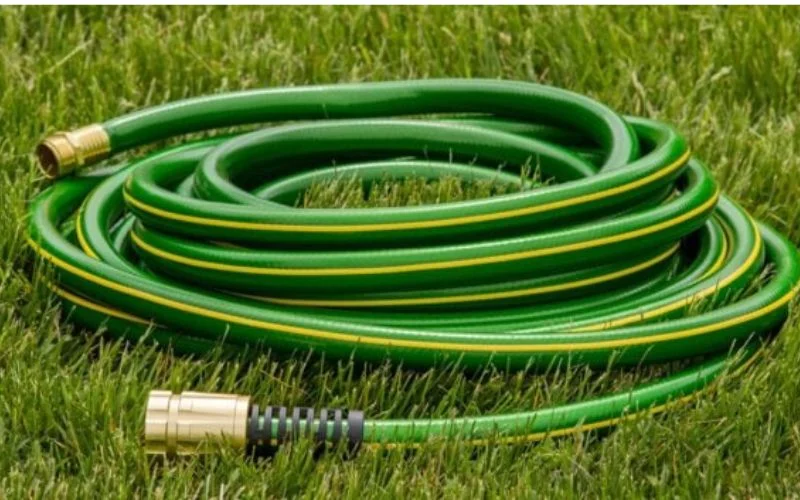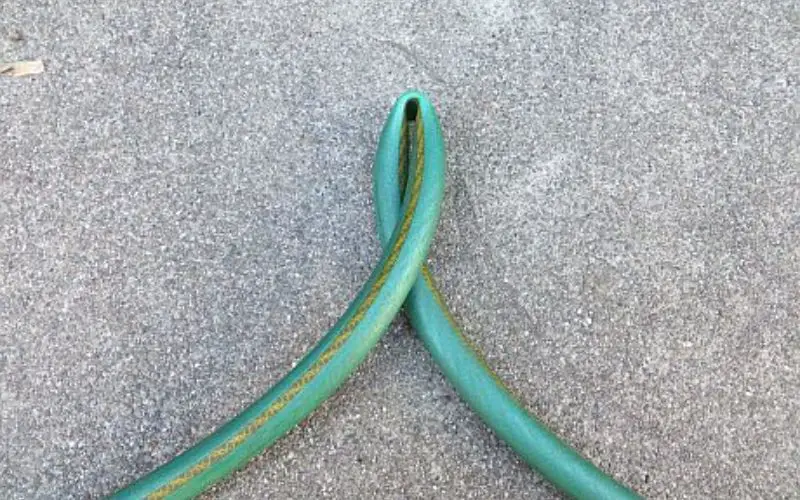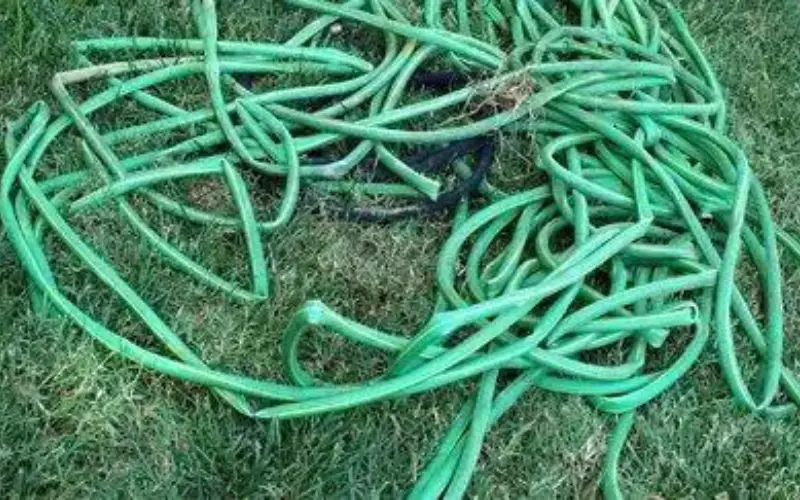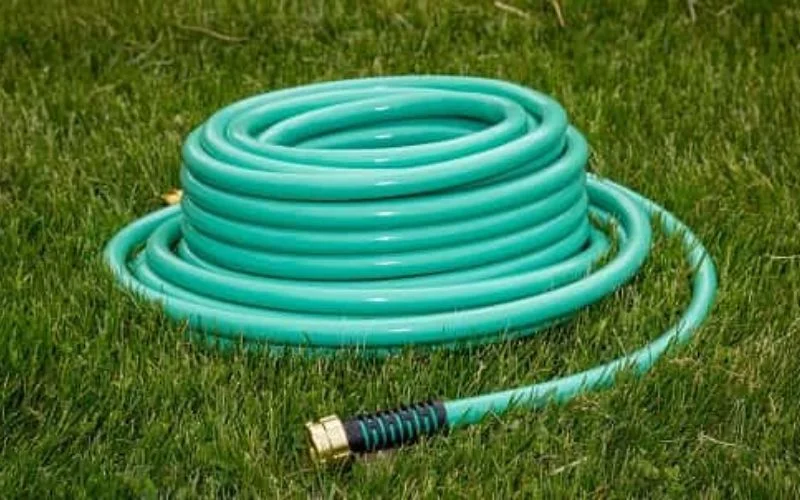A garden hose is handy gardening equipment that makes watering our lawns and gardens very easy, but using a stiff hose can be frustrating. Leaks, won’t unwind, or worse still, kinks.
A kink is a sharp bend that happens when the hose gets pulled tightly from a loop and results in the cutting off of the water supply. If the kink becomes frequent in a particular part of the hose, it can permanently damage the hose.
Kinks can be prevented by storing the hose properly especially using a reel, and ensuring that it is not kept in the sun for long nor stored with water inside.
Comparison Of Different Types Of Gardening Hose

The main difference between the different types of hoses there is the material they are made of. Here are some of the most common types of hose that there are:
Vinyl hoses
It is one of the most common types of hoses, and in most cases, they are reinforced with nylon mesh or cording to make them durable and robust.
They are suitable hoses for sprinkler irrigation, where water must be sprinkled on an area for a long time. Vinyl hoses are inexpensive but hard to recoil, tend to be stiff, and often kink easily.
Polyurethane hoses
These lightweight hoses do not kink as easily as vinyl hoses, but they are a bit stiff and a little challenging to coil or bend when pulling them through the garden.
Rubber hoses
If you get a construction-grade rubber hose, you will get a very durable hose that will last you for a long time.
These hoses are pliable and easy to coil; hence, kinks can easily be shaken off and will not leave a crease where they will kink again. The only problem is that they ate relatively heavy and might leave stains on your clothes and hands if rubbed too hard.
Polymer hoses
Polymer hoses are soft, flexible, lightweight, and drinking water safe. It gently curls around corners, plants, and pots, and storing them is easy because it coils easily. Even though polymer hose kinks are easy, “unkinking'” them is easy, and they do not leave creases that set.
Metal hose
This hose has the advantages that it is lightweight, rugged, and, thankfully, does not kink easily. It easily uncoils and quickly loses heat that it gains from the sun when left outside. It is, however, pricey and can catch on pavement cracks and corners.
Expandable hose
There are different versions of expandable hose, usually a rubber tube encased by a durable, stretchy fabric. It is light and straightforward to store. For instance, a 100 feet expandable hose can fit in a 5-gallon bucket. You, however, have to keep coiling it as you use it.
Soaker hoses
Soaker hoses are very water efficient. After all, less water is used when watering the lawn or garden because the water is directed right into the soil near the roots where it’s needed. You should know how long to let your soaker hose run by turning the faucet on a quarter and letting it run for an hour. If the soil is still moist at least 2 inches down by the next day, you can let it keep running for an hour. If the soil is dry the next day, you must let the hose run for longer.
What Causes Hoses To Kink?

“Kinking” of a garden hose occurs when there is a bend, especially at the weak point in the hose, which is 90 degrees or more. It prevents the water from flowing freely. Many hoses are tagged “kink-free,” but in reality, every hose gets kinked occasionally.
The main reason why hoses get kinked is how they are stored. When people water their lawns, they leave their hose in a spool or curled-up pile, which results in the hose getting compressed and tangled. However, when one takes time to straighten out the hose from storing them, it will keep them from getting kinked.
Once a hose is kinked in a spot, the material begins to weaken, and once the hose material is used to being in that position, it will always assume that position even when it is stretched out, so the hose continues to kink.
The thickness of the hose material will affect how easily it kinks. The thicker the hose, the less likely it is to kink, meaning thinner hoses kink more.
How Do I Prevent Kinks In My Garden Hose?

The key to preventing kinks in the hose is proper storage. Once a hose is stored correctly, the chances of them getting tangled are significantly reduced. Below are some ways of storing hoses:
Use a Reel for Your Garden Hose
Garden hose reels are a very convenient way to store and transport hoses. Because of how the reel store the hose, it prevents the hose from tangling and having knots or damage, which means that it can prevent kinks.
We must, however, state that because of how the reel stores the hose, the hose will maintain its shape when it unravels, which means that it does not entirely rule out the possibility of kinks. Yet, people will always go for a garden hose reel because it makes carrying and storing hoses much easier.
Leave It Stretched Out Straight
Simply leaving your garden hose stretched out and straight on the lawn is an excellent way to keep it from developing kinks. Many people leave their hose as it is attached to the hook-up after watering their lawn or garden so that the hose doesn’t get rolled up at all.
The only problem with this method is that it leaves the hose exposed to the element, which will cause them to quickly west and tear. It will mean you must replace the hose earlier than its usual lifespan because of leaks from deterioration from the elements.
Use A Free-Standing Holder
A wall mount or free-standing holder is an excellent way of storing your hose. This upside-down “U” shaped mount can be pushed to soft ground or installed on a wall. This holder neatly stores the hose and prevents it from kinks because it reduces the number of places it loops.
Other Ways To Prevent Kinks And Care For Your Hose
When you look after your garden hose, it will not only prevent kinks, leakage, and damage but will always make watering your garden and lawn less stressful and time-consuming. Here are ways of preventing kinks from your hose and also caring for it:
Store The Hose Properly
Rolling or looping your hose too tight will always lead to kinks, just as hanging a hose from just one hook will have the same effect because pressure built up by the single point of contact will not only cause kinks in the hose but also damage the long run.
Lay The Hose In The Sun
When you finish watering your lawn, don’t immediately wind it up in the reel, but allow them to sit in the sun for a while to help the hose expand and remain straight. However, please don’t keep it under direct sun for too long as this can damage the outer walls. Half an hour to an hour is fine.
Get Water Out Of Hose
Get rid of water that lingers in the hose after watering your lawn or garden by laying the hose downhill so that the water will drain out more quickly.
Getting all the water trapped in the hose out is essential to prevent the rubber from rotting and staying too damp.
Detach The Hose From Garden Tap When Not In Use
There is always that tendency to leave our hose attached to our garden rap. It is not a great idea because any water from the tal will stay inside the tubing, and it will cause the hose to rot.
Water Carefully
As you water your lawn or garden, be careful and ensure that you do not twist the hose behind you as you go. Unhook it from any obstacle and keep it straight all the time, preventing the hose from stretching and kinking.
Repair Kinks
If your hose already has a kink, leave it outside under the sun for a while and turn on the water for a while. What will happen is that the heat of the sun, together with the pressure of the water in the hose, will cause the walls to expand outwards. By so doing, the signs of kinking will stop.
Use Anti-Kinking Accessories
While this will not stop kinks 100%, an anti-kinking accessory helps stop cracks or bend from appearing in the first place. Kink out is an excellent anti-kinking product to try.
Conclusion
Watering your lawn or garden is one of the many prices you must pay to enjoy your beautiful serene environment. Still, one frustrating part of this chore is that when kinks appear in your garden hose, they can stop water from flowing through it and impede your progress.
Helpful Links:
- How Does Weed Puller Work
- Why Do Weeds Die in the Winter
- Best Weed Puller Removal Tool To Buy
- Why Is My Echo Weed Eater Won’t Start
- Is a 4-cycle Weed Eater Better Than a 2-cycle?
You can prevent this by storing your hose never and adequately, leaving your hose outside or tangled.
Kindly reach out to people by sharing this post on social media.
If you liked this article, then please follow us on Facebook, Instagram, Twitter, and Pinterest.

